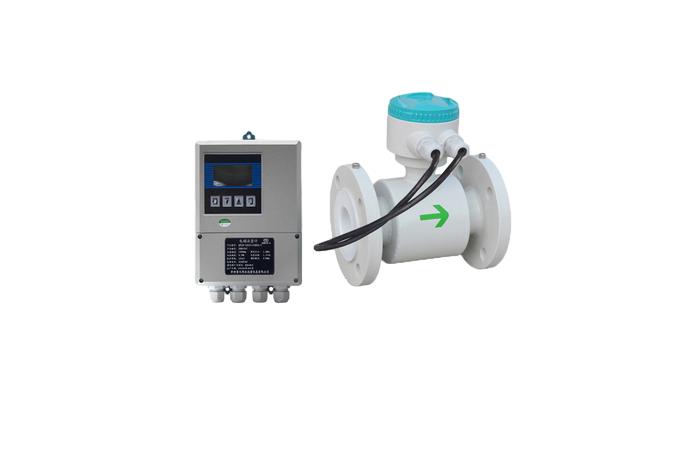Air conditioning water electromagnetic flowmeter in the selection of installation points need to pay attention to the main points
2023-12-29
The selection of the location and installation point of the air conditioning water electromagnetic flowmeter is very important for the normal operation and measurement accuracy of the system. Here are some points to look out for:

Flowmeter location:
The uniformity of the fluid flow should be considered when selecting the measuring point, and the installation should be avoided in places where bending, diverging, confluence and so on interfere with the flow.
Avoid installation in areas with large changes in water velocity to ensure the stability and accuracy of the flow meter.
Choose a location far away from the pump outlet and valve inlet to ensure fluid stability and avoid unnecessary vibration and pulsation of the flow meter.
Installation point:
It is installed on the horizontal pipe section to ensure that the water flow direction is consistent and to avoid sloping up and down.
Before installation, the impurities in the pipeline should be cleaned so as not to affect the normal operation of the flowmeter.
Avoid the presence of bubbles in the pipe, as bubbles may affect the conductivity of the fluid.
Pipe diameter and length:
The accuracy of the flow meter is usually better within a certain range of pipe diameters and lengths, so the diameter and length of the pipe should be considered when selecting the installation point.
Avoid installation at bends and branches of the pipe to ensure uniform flow of fluid.
Environmental Conditions:
Considering ambient temperature, humidity and other environmental factors, select appropriate protective measures to ensure the stability and life of the flow meter.
Avoid direct sunlight or extreme temperature conditions.
Electromagnetic interference:
Stay away from electromagnetic interference sources, such as strong current cables, frequency converters, etc., to avoid the influence of electromagnetic flowmeters.
If necessary, shielding measures can be taken to ensure the accuracy of the meter measurement.
Installation direction:
Select the appropriate installation direction according to the flow direction of the fluid to ensure that the flow meter can work properly.
Ground:
Ensure that the metal part of the flow meter is effectively grounded to prevent static interference.
Before installation, it is best to refer to the installation manual of the specific flow meter model and the manufacturer's recommendations to ensure that the correct steps and requirements are followed. At the same time, it is best to install and debug by professional technicians to ensure the reliability of the system and the accuracy of measurement.

Flowmeter location:
The uniformity of the fluid flow should be considered when selecting the measuring point, and the installation should be avoided in places where bending, diverging, confluence and so on interfere with the flow.
Avoid installation in areas with large changes in water velocity to ensure the stability and accuracy of the flow meter.
Choose a location far away from the pump outlet and valve inlet to ensure fluid stability and avoid unnecessary vibration and pulsation of the flow meter.
Installation point:
It is installed on the horizontal pipe section to ensure that the water flow direction is consistent and to avoid sloping up and down.
Before installation, the impurities in the pipeline should be cleaned so as not to affect the normal operation of the flowmeter.
Avoid the presence of bubbles in the pipe, as bubbles may affect the conductivity of the fluid.
Pipe diameter and length:
The accuracy of the flow meter is usually better within a certain range of pipe diameters and lengths, so the diameter and length of the pipe should be considered when selecting the installation point.
Avoid installation at bends and branches of the pipe to ensure uniform flow of fluid.
Environmental Conditions:
Considering ambient temperature, humidity and other environmental factors, select appropriate protective measures to ensure the stability and life of the flow meter.
Avoid direct sunlight or extreme temperature conditions.
Electromagnetic interference:
Stay away from electromagnetic interference sources, such as strong current cables, frequency converters, etc., to avoid the influence of electromagnetic flowmeters.
If necessary, shielding measures can be taken to ensure the accuracy of the meter measurement.
Installation direction:
Select the appropriate installation direction according to the flow direction of the fluid to ensure that the flow meter can work properly.
Ground:
Ensure that the metal part of the flow meter is effectively grounded to prevent static interference.
Before installation, it is best to refer to the installation manual of the specific flow meter model and the manufacturer's recommendations to ensure that the correct steps and requirements are followed. At the same time, it is best to install and debug by professional technicians to ensure the reliability of the system and the accuracy of measurement.
Share To:
Previous Post:
News
- Why is the thermal gas mass flowmeter not affected by pressure strength and temperature?
- What to do when a thermal gas mass flow meter fails?
- How are thermal gas mass flow meters used? What are the applications?
- Under what circumstances is the gas measurement need to be regulated compensated vortex flowmeter
- Why Is The Aister Thermal Gas Mass Flowmeter So Popular ?
- Gas turbine flowmeter manufacturers explain their main advantages in measurement
- Gas turbine flowmeter manufacturer Aister instrument field experience summary
- Aister Instrument Empowerment Conference








